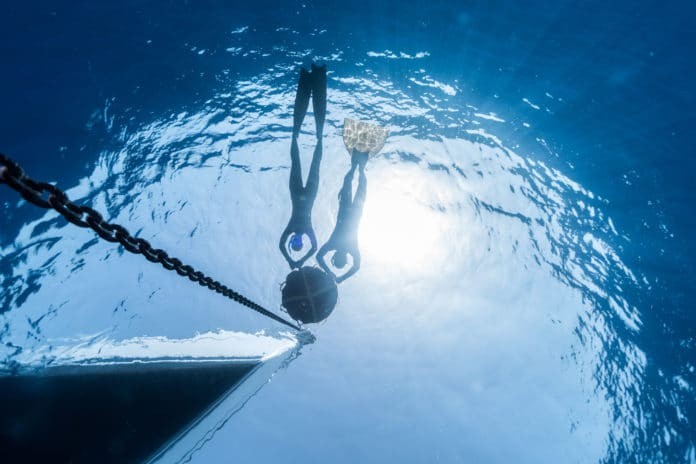Something that we all have to remember is that experience does not necessarily mean the eradication of mistakes. Sure, experienced freedivers will most likely not make the same mistakes as beginners do, but with depth and distance comes different mistakes and a different (sometimes overconfident) mindset. So as with our articles about common mistakes beginner freedivers and intermediate freedivers make, this one will focus on common mistakes made by advanced freedivers. Here, we will refer to advanced freedivers as freedivers who go 40m and deeper.
Mouthfill issues
There are a lot of issues that freedivers can have with Mouthfill. Learning it can be a tricky process already, but keeping it to the end of the line can feel impossible. There are many reasons people swallow their fill: too much tension, relaxing the glottis, early contractions, swallowing, etc. There are videos out there that discuss this issue and are designed to help, like this video from Andrea Zuccari. Some freedivers also have a lack of awareness of their Mouthfill and are not able to access all of the air in their mouths or refill incorrectly. For Mouthfill issues, there are plenty of resources online that aim to help out, but what would benefit an advanced freediver the most would be personalized coaching from someone who is familiar with Mouthfill issues and how to overcome them.
Too deep, too fast
This mistake applies to intermediate freedivers but does not stop there. Many freedivers can get “PB (Personal Best) Syndrome,” and try to advance much too quickly, getting obsessed with splashing big numbers on their dive computers. While it is an exciting and feel-good time to celebrate a new depth reached, freedivers should not be in a hurry to conquer deeper depths too quickly. The deeper you go, the more critically important it is to acclimatize yourself depth-wise, or else risk a nasty squeeze. Different freedivers have different methodologies to increasing numbers, such as repeating a PB 10 times and then adding a meter or two. In the end, a conservative approach is always best.
No proper training plan
Without organization, training sessions can become a hit-or-miss in terms of reaching your target depth. These are the dives where your chances of reaching the end of the line or turning early are equal, or in worse cases, higher for turning early. This is not optimal for progression; these are gamble dives, where you might get lucky and reach your target, but you also might not. This can encourage a high failure rate, which is not conducive to freediving psychology. It is more effective to create a training plan that includes well-based progress so that it can be maintained and repeated.
Overtraining
Some freedivers so often get addicted to results and believe that non-stop training is the only way to obtain positive results in training, but many top athletes will tell you different. Overtraining can cause a plateau when it comes to results, stress, anxiety, frustration, a lack of motivation to train, and even cause a feeling of dread at the thought of getting into the water. Taking a break from training is not only good for over-trained freedivers physically, but also mentally. Some solutions are getting some fun diving in, hanging out with non-freedivers, and trying some other non-freediving activities. Just a simple break from all of the pressure we put on ourselves can ease the burden of overtraining, and after that, simply approaching training from a different perspective.
Relaxation
You would think that experienced freedivers have relaxation mastered after having practiced it so often, but relaxation gets more difficult with increasing depth, yet is essential for equalization. Finding true relaxation for the muscles in our core is difficult. As relaxed as a freediver might feel, micro-tensions can easily be present and remain unnoticed. Even keeping an extended arm around the line during freefall can send tension to the shoulder and upper chest. Visualization before a dive is a technique that can greatly improve relaxation during the actual dive. Becoming more aware of your body in an organized manner and being able to find small tensions and relax them will also help, instead of being overwhelmed by sensations during your dive.

